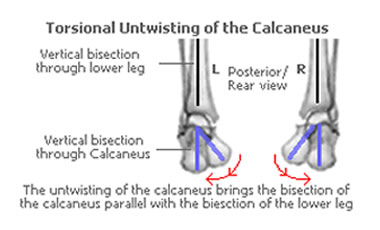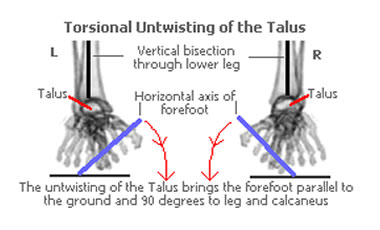Foot Shape Variation
Foot shape variations are controlled by the structure of the foot, which is set in the first trimester of pregnancy. Like other characteristics such as hair and eye colour, foot structure and the resulting foot shape variations it creates are variable, and likely also inherited.
The graphics below show how the structure of the foot develops, through the torsional untwisting of the two biggest bones in the foot, the calcaneus (heelbone) and talus, during feotal development.
How these two bones control foot shape variations
The position of the calcaneus controls the angle of the rearfoot. As the calcaneus untwists, the rearfoot rotates about its vertical axis, bringing the rearfoot in line (parallel) with the lower leg.
The position of the talus controls the angle of the forefoot. As the talus untwists, the forefoot rotates about its’ horizontal axis so that it is parallel with the horizontal. The ideal alignment of the talus is when the forefoot:
- is at 90 degrees (perpendicular) to the vertical line drawn through the calcaneus (heelbone) and lower leg, and
- parallel with the horizontal
Club Foot
If the calcaneus and talus fail to unwind at all, or only very minimally, it creates what is commonly known Club foot (congenital talipes equinovarus) This is a fairly common congenital birth problem, affecting around 1 in 1,000 births.
Variety and uniqueness
The degree of torsional untwisting is unique in each of us, and is normally different in the rearfoot and forefoot of each foot. The result is a natural foot shape combination, unique to each foot, where the foot retains some degree of torsional twisting about the vertical (rearfoot)and/or horizontal axes (forefoot). This is assessed by placing the foot the Sub-Talar joint neutral.
Because the structural alignment of the calcaneus and talus is set by the end of the 1st Trimester of pregnancy, such foot shape variations are termed congenital, meaning present at birth. The physical bony alignment present at birth remains unchanged through life.
Varus and Valgus
There are two types of foot shape:
- a natural Varus, or inverted shape created as a result of insufficient torsional untwisting
- a natural Valgus, or everted foot shape created as a result of excessive torsional untwisting
Varus and Valgus deformities can affect both the calcaneus and the talus, as shown below:
| NATURAL FOOT SHAPE VARIATIONS |
Varus |
Valgus |
| Calcaneus (controls position of rearfoot) |
Rearfoot Varus
|
Rearfoot Valgus
|
| Talus (controls position of forefoot) |
Forefoot Varus
|
Forefoot Valgus
|
The link to Foot Shapes
Varus and valgus deformities are the underlying structural cause for the Three Foot Shapes (Pronator, Normal and Supinator)
- The natural varus deformity is by far the most common, and typically results in a Pronator foot shape
- The natural valgus deformity is rare, and forms the basis for the Supinator foot shape
- Where no significant varus or valgus deformity exists, the foot is a Normal foot shape
Cause
The cause for these variations in the torsional untwisting of the calcaneus and/or talus (from Club foot right through to the smallest alignment problems) is as yet unknown, but it is thought to have some genetic tendencies.


